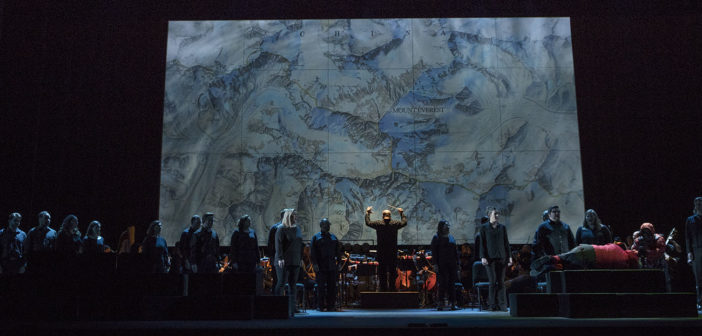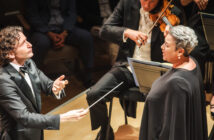BY PAUL E. ROBINSON ON 26 JANUARY 2020
Austin, TX – Joby Talbot’s one-act opera Everest was composed in 2014, and is based on an ill-fated Mount Everest expedition in 1996 in which several climbers perished. The premiere was presented by Dallas Opera in a fully staged version. Three years later it was again performed in Dallas but this time in a semi-staged version with the orchestra on stage. It was this version that was offered last week by Austin Opera at the Long Center for the Performing Arts.
Among the survivors from the 1996 expedition was the journalist Jon Krakauer. He has written a best-selling book about the experience until the title Into Thin Air. In the book Krakauer expresses guilt about mistakes he may have made that contributed to the loss of life. But another survivor, Anatoli Boukreev, remembered it differently and set down his own account in his book The Climb: Tragic Ambitions on Everest. Yet a third survivor, the Dallas pathologist Dr. Beck Weathers, and one of the characters depicted in the opera, has written a book titled Left for Dead: My Journey Home from Everest. In addition, several films have been made dealing with the disaster.
The libretto for the opera was written by Gene Scheer and is based on interviews with survivors of the 1996 tragedy. While several teams were involved in the disaster, Scheer and composer Joby Talbot chose to concentrate on just three of the climbers: the guide and team leader Rob Hall and his customers Doug Hansen and Dr. Weathers. Rob’s wife Jan also figures in flashbacks and a phone call and Dr. Weathers’ daughter Meg appears in his hallucinations. In addition, there is a chorus of the souls of other climbers who lost their lives on Mt. Everest; the chorus provides a commentary on the action.
In the semi-staged version given in Austin the singers perform in a small space at the front of the stage. They are in costume as climbers with the chorus and orchestra behind them in black. Above them is a large screen on which there are slowly changing projections (designed by Elaine J. McCarthy) depicting scenes on the mountain.
The plot focusses on events which took place over a period of two days. In fact, these are the last days of Rob Hall and Doug Hansen as they die due to lack of oxygen and the extreme cold. We also see Dr. Weathers struggling to survive in another location. Leonard Foglia was the stage director at the Dallas premiere and in Austin, and tells us in a program note that the opera is more than a physical depiction of the last moments of courageous men trying to conquer Mt. Everest. Rather, it is an exploration of their minds as they fight to simultaneously breathe and to find meaning in what is happening to them.
The singers were uniformly excellent. All three leading characters, bass Kevin Burdette as Dr. Beck Weathers, tenor Andrew Bidlack as Rob Hall and baritone Craig Verm as Doug Hansen had sung in the Dallas premiere in 2015, and had total command of Talbot’s challenging vocal writing although Burdette’s exaggerated Texas accent was pretty unconvincing. Joseph Mechavich led the Austin Opera Orchestra with clarity and precision.
Unfortunately, while librettist and composer focus our attention on the doomed climbers, the central character in this drama is the mountain, and it was sadly under-represented and misrepresented. This was primarily the fault of the projections. The mountain scenes depicted on the screen were far from the best available. The cinematography in the 2015 film Everest gives us the iconic peak in all its awesome and fearsome beauty. What we see in the film is truly one of the wonders of the world. And the challenge of trying to conquer such a monster is captured perfectly. In McCarthy’s static and washed out projections we see virtually nothing to marvel at let alone fear. In 2020 with the Everest footage available and state of the art technology, we have come to expect something much better. Nor was Talbot’s music strong enough or vivid enough to carry the day. There were plenty of exotic instruments and sound effects in the score but little of it was memorable. Would it have been better to use more abstract projections? Perhaps that would have set aside the inevitable comparisons with existing spectacular footage of the real Mt. Everest. But in that case, the lead characters would have to be costumed more neutrally rather than in climbing gear. And again, one has the problem that the music alone is not strong enough to be a convincing representation of Mt. Everest nor of howling winds, driving snow and bitter cold.
Director Foglia told us that the opera is really about exploring the minds of the climbers. But librettist Scheer barely scratches the surface of what might go through the mind of a dying man. Setting aside the question of how much real thinking a man can do when he is seriously oxygen-deprived, one would want to explore what kind of man would be driven to try to climb Mt. Everest in the first place. To say the least this is an extreme sport and many hundreds of men have lost their lives doing it. And by 1996 many men had succeeded too, starting with Sir Edmund Hillary in 1953. So why do it? And surely dying men, even in their hallucinations – perhaps especially in their hallucinations – also reflect on what they have achieved in their lives and what they will leave behind as they depart this earth. Interestingly, when the European premiere of Everest was given in 2018, presumably with the approval of Talbot and Scheer, instead of mountain-climbing scenes and mountaineers in full climbing gear, the producers set the opera in a sanatorium and attempted “to make the hallucinations of the mountaineers visible.” Based on what I saw in Austin, the work cries out for an alternative approach.
But while Everest has some fairly major conceptual flaws, Joby Talbot has long since established himself as a composer capable of great things. Just a few years ago the Austin-based choral group Conspirare performed and recorded the composer’s totally enthralling magnus opus Path of Miracles, inspired by the ancient pilgrimage from France to Spain’s Cathedral of Santiago de Compostela. And Dallas Opera has such faith in Joby Talbot’s operatic gifts and Gene Scheer’s writing talent they have commissioned The Diving Bell and the Butterfly, to be premiered next season, in March, 2021.
Austin Opera has one more production this season, Puccini’s Turandot in a production borrowed from Lyric Opera of Kansas City, and it will have three performances April 25 – May 3. Next season Austin Opera will give the local premiere of Mason Bates The (R)evolution of Steve Jobs, along with Tosca and The Marriage of Figaro. In timely fashion it will also offer Sarah Kirkland Snider’s Penelope billed as “Austin Opera’s first opera by a female composer.”
Finally, Austin Opera deserves credit not only for consistently presenting new work along with the old favorites, but also for at least dipping its toes in new technology. For example, the program book for Everest made use of a QR code on the cover to transport interested patrons to supplemental material on both the mountain and the opera. Admittedly, this first venture in Augmented Reality was very limited in scope but it opens up a whole new world of possibilities, especially for a younger generation.















